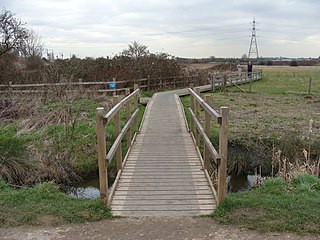
The London Borough of Waltham Forest is a London borough in north-east London, England. Its population is estimated to be 276,983 in 2019. It borders five other London boroughs: Enfield to the north-west, Haringey to the west, Hackney to the south-west, Newham to the south-east and Redbridge to the east, as well as the non-metropolitan county of Essex to the north.

The Nebelwerfer was a World War II German series of weapons. They were initially developed by and assigned to the Wehrmacht's "smoke troops" (Nebeltruppen). Initially, two different mortars were fielded before they were replaced by a variety of rocket launchers ranging in size from 15 to 32 centimetres. The thin walls of the rockets had the great advantage of allowing much larger quantities of gases, fluids or high explosives to be delivered than artillery or even mortar shells of the same weight. With the exception of the Balkans Campaign, Nebelwerfer were used in every campaign of the German Army during World War II. A version of the 21 cm calibre system was adapted for air-to-air use against Allied bombers.
The 9th Mountain Division was the name given to two separate German military divisions by accident in 1945.
German Division Nr. 188 was raised in late 1939. It consisted of the 136th, 138th and 139th Mountain Replacement Regiments and the 112th Artillery Replacement Regiment, plus supporting units. It began the war on border guard duty in the mountainous region between Austria and Yugoslavia with the primary mission of training reservists and replacements for the regular mountain divisions. In the spring of 1941 it joined the invasion of Yugoslavia, with the three mountain regiments given responsibility of seizing control of Carniola and Carinthia on the Yugoslav side of the border, which they carried out quickly and effectively against little to no resistance.
The Panzerkorps Großdeutschland was a German panzer corps in the Wehrmacht which saw action on the Eastern Front in 1944/1945 during World War II.

V-weapons, known in original German as Vergeltungswaffen, were a particular set of long-range artillery weapons designed for strategic bombing during World War II, particularly strategic bombing and/or aerial bombing of cities. They were the V-1, a pulsejet-powered cruise missile; the V-2, a liquid-fueled ballistic missile ; and the V-3 cannon. Germany intended to use all of these weapons in a military campaign against Britain, though only the V-1 and V-2 were so used in a campaign conducted 1944–45. After the invasion of western Europe by the Allies, these weapons were also employed against targets on the mainland of Europe, mainly in France and Belgium. Strategic bombing with V-weapons killed approximately 18,000 people, mostly civilians. The cities of London, Antwerp and Liège were the main targets.

Walthamstow Marshes, is a 36.7-hectare (91-acre) biological Site of Special Scientific Interest in Walthamstow in the London Borough of Waltham Forest. It was once an area of lammas land – common land used for growing crops and grazing cattle.

The 69th Infantry Division was a combat division of the German Wehrmacht during the Second World War.

The Lee Valley Reservoir Chain is located in the Lee Valley, and comprises 13 reservoirs that supply drinking water to London.

Leyton Marsh is an open space in the Lower Lea Valley, located in Leyton in the London Borough of Waltham Forest.

The 21 cm Nebelwerfer 42 was a German multiple rocket launcher used in the Second World War. It served with units of the Nebeltruppen, the German equivalent of the American Chemical Corps. Just as the Chemical Corps had responsibility for poison gas and smoke weapons that were used instead to deliver high-explosives during the war so did the Nebeltruppen. The name "Nebelwerfer" is best translated as "Smoke Mortar". It saw service from 1942–45 in all theaters except Norway. It was adapted for aerial combat by the Luftwaffe in 1943.

The 30 cm Nebelwerfer 42 was a German multiple rocket launcher used in the Second World War. It served with units of the Nebeltruppen, the German equivalent of the U.S. Army's Chemical Corps. Just as the Chemical Corps had responsibility for poison gas and smoke weapons that were used instead to deliver high-explosives during the war so did the Nebeltruppen. The name "Nebelwerfer" is best translated as "Smoke Mortar". It saw service from 1943 to 1945 in all theaters except Norway and North Africa.

The 30 cm Raketenwerfer 56 was a German multiple rocket launcher used in the Second World War. It served with units of the Nebeltruppen, the German equivalent of the U.S. Army's Chemical Corps. Just as the Chemical Corps had responsibility for poison gas and smoke weapons that were used instead to deliver high-explosives during the war so did the Nebeltruppen. The name "Nebelwerfer" is best translated as "Smoke Mortar". 694 saw service from 1944–45 in all theaters except Norway.

Eduard Crasemann was a German General der Artillerie in the Wehrmacht and convicted war criminal who commanded several Panzer divisions during World War II.
II Army Corps was a corps in the German Army during World War II.

The 81st Infantry Division was an infantry division of the German Army during World War II.
1st Anti-Aircraft Group was a formation created by the British Army's Anti-Aircraft Command in 1942 to control anti-aircraft (AA) units defending London against Luftwaffe attacks during World War II. It continued this role into the Cold War until disbandment in 1955.
The 549th Volksgrenadier Division was a volksgrenadier infantry division of the German Army during World War II, active from 1944 to 1945. It was formed as the 549th Grenadier Division in July 1944 and became a volksgrenadier division several months later. Fighting on the Eastern Front, it was nearly destroyed in the East Prussian Offensive, with its remnants retreating west and surrendering to American troops at the end of the war.
The 166th Infantry Division was an infantry division of the German Heer during World War II. The unit, at times designated Commander of Reserve Troops 2 of Wehrkreis VI (













